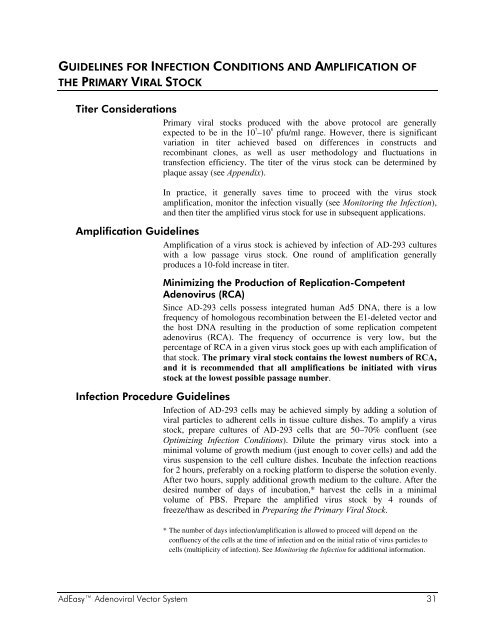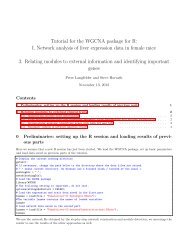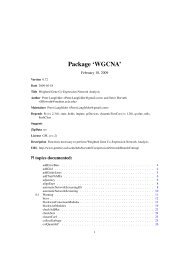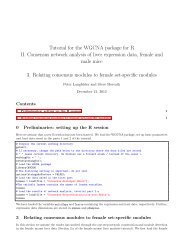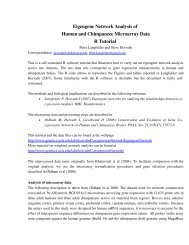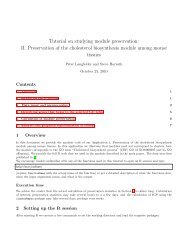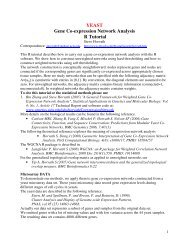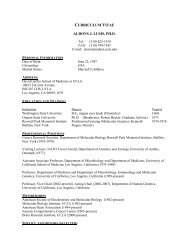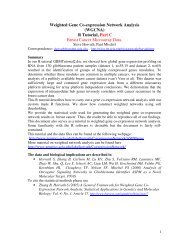Manual: AdEasy Adenoviral Vector System - UCLA Human Genetics
Manual: AdEasy Adenoviral Vector System - UCLA Human Genetics
Manual: AdEasy Adenoviral Vector System - UCLA Human Genetics
You also want an ePaper? Increase the reach of your titles
YUMPU automatically turns print PDFs into web optimized ePapers that Google loves.
GUIDELINES FOR INFECTION CONDITIONS AND AMPLIFICATION OF<br />
THE PRIMARY VIRAL STOCK<br />
Titer Considerations<br />
Primary viral stocks produced with the above protocol are generally<br />
expected to be in the 10 7 –10 8<br />
pfu/ml range. However, there is significant<br />
variation in titer achieved based on differences in constructs and<br />
recombinant clones, as well as user methodology and fluctuations in<br />
transfection efficiency. The titer of the virus stock can be determined by<br />
plaque assay (see Appendix).<br />
In practice, it generally saves time to proceed with the virus stock<br />
amplification, monitor the infection visually (see Monitoring the Infection),<br />
and then titer the amplified virus stock for use in subsequent applications.<br />
Amplification Guidelines<br />
Amplification of a virus stock is achieved by infection of AD-293 cultures<br />
with a low passage virus stock. One round of amplification generally<br />
produces a 10-fold increase in titer.<br />
Minimizing the Production of Replication-Competent<br />
Adenovirus (RCA)<br />
Since AD-293 cells possess integrated human Ad5 DNA, there is a low<br />
frequency of homologous recombination between the E1-deleted vector and<br />
the host DNA resulting in the production of some replication competent<br />
adenovirus (RCA). The frequency of occurrence is very low, but the<br />
percentage of RCA in a given virus stock goes up with each amplification of<br />
that stock. The primary viral stock contains the lowest numbers of RCA,<br />
and it is recommended that all amplifications be initiated with virus<br />
stock at the lowest possible passage number.<br />
Infection Procedure Guidelines<br />
Infection of AD-293 cells may be achieved simply by adding a solution of<br />
viral particles to adherent cells in tissue culture dishes. To amplify a virus<br />
stock, prepare cultures of AD-293 cells that are 50–70% confluent (see<br />
Optimizing Infection Conditions). Dilute the primary virus stock into a<br />
minimal volume of growth medium (just enough to cover cells) and add the<br />
virus suspension to the cell culture dishes. Incubate the infection reactions<br />
for 2 hours, preferably on a rocking platform to disperse the solution evenly.<br />
After two hours, supply additional growth medium to the culture. After the<br />
desired number of days of incubation,* harvest the cells in a minimal<br />
volume of PBS. Prepare the amplified virus stock by 4 rounds of<br />
freeze/thaw as described in Preparing the Primary Viral Stock.<br />
* The number of days infection/amplification is allowed to proceed will depend on the<br />
confluency of the cells at the time of infection and on the initial ratio of virus particles to<br />
cells (multiplicity of infection). See Monitoring the Infection for additional information.<br />
<strong>AdEasy</strong> <strong>Adenoviral</strong> <strong>Vector</strong> <strong>System</strong> 31


